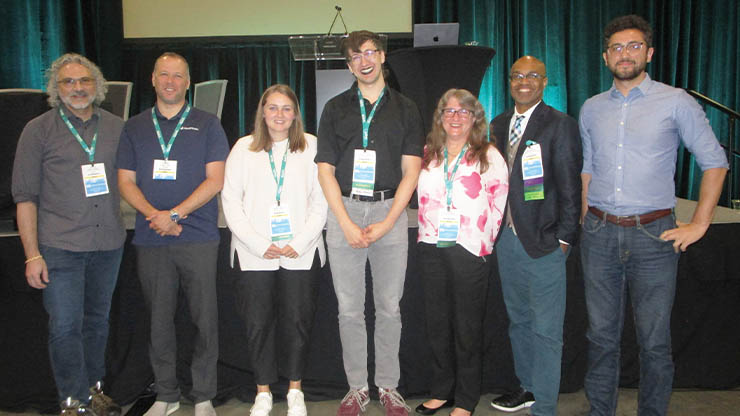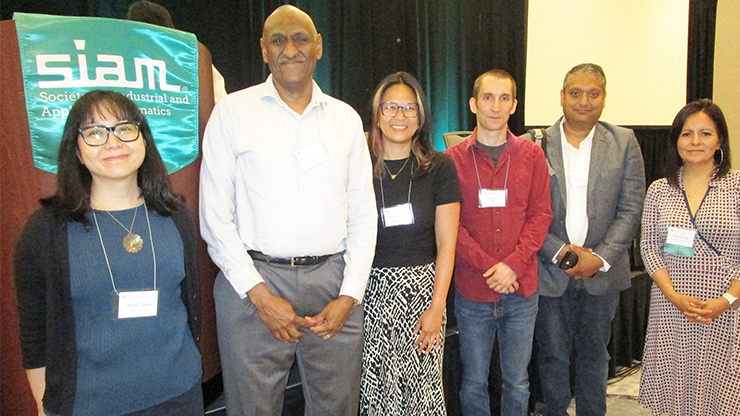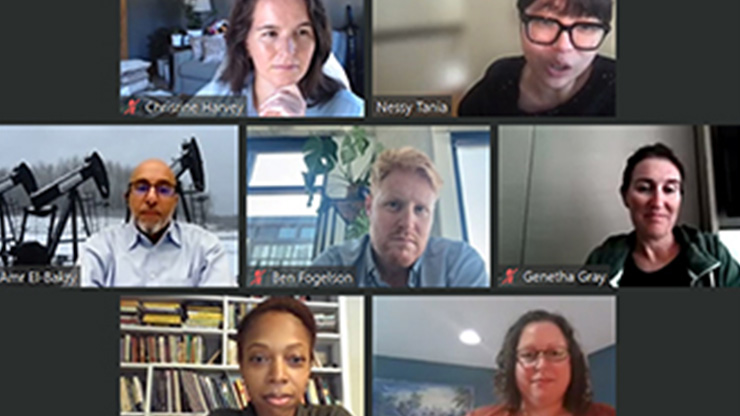MPE24 Panel Explores Mathematical Careers in Earth Science and Sustainability
Mathematicians who are passionate about the environment have many opportunities to bridge these two fields. Applied mathematics, computational science, and data science directly contribute to studies on climate modeling, ecological dynamics, and clean energy technologies — among numerous other application areas in science, technology, engineering, and mathematics (STEM). While these connections are not always clear from the outset, a multitude of paths within academia, industry, and the national laboratories lead to jobs that focus on important research questions that are rooted in Earth science.
During the 2024 SIAM Conference on Mathematics of Planet Earth (MPE24), which took place in Portland, Ore., this past June, a panel of researchers discussed career trajectories for mathematically inclined individuals who are also enthusiastic about MPE. Alex Cannon of the Meteorological Service of Canada chaired the conversation between Nicole Jackson of Sandia National Laboratories, Alice Nadeau of C.H. Robinson, and Thordis Thorarinsdottir of the University of Oslo, all of whom overviewed the ways in which STEM careers can encompass both mathematical methods and domain applications in the broad realm of Earth and environmental science.
Initial conversation centered on whether graduate school is necessary to work in this space. Nadeau—who performs backend data analytics for carbon emission reporting tools at a third-party logistics company—provided an industry-based point of view. “On my team, there’s a mix,” she said. “Half of my team started right after undergrad as entry-level data analysts and moved up, and the other half are academic converts.” In light of this flexibility, Nadeau urged students to consider their personal motivations: Would they rather enter the workforce immediately or pursue graduate school and postdoctoral appointments, given that such credentials are not strict requirements for MPE-relevant occupations? “Graduate school isn’t a necessary condition in my case,” she said.
However, Thorarinsdottir cautioned that individuals who do not obtain advanced degrees may find themselves passed up for promotions or opportunities to tackle more interesting problems. She suggested that one might wish to earn an undergraduate degree, work for a few years to gain real-world experience, then revaluate personal and professional goals and potentially return to graduate school. Jackson noted that Sandia National Laboratories’ robust internship program can lead to permanent employment for successful and engaged undergraduate students. But while Sandia hires employees at all educational levels, graduate degrees may indicate a stronger aptitude for problem-solving and accelerate pathways towards leadership roles. “You shouldn’t let the job market dictate your educational goals,” Jackson said. “You should do it because it matters to you.”
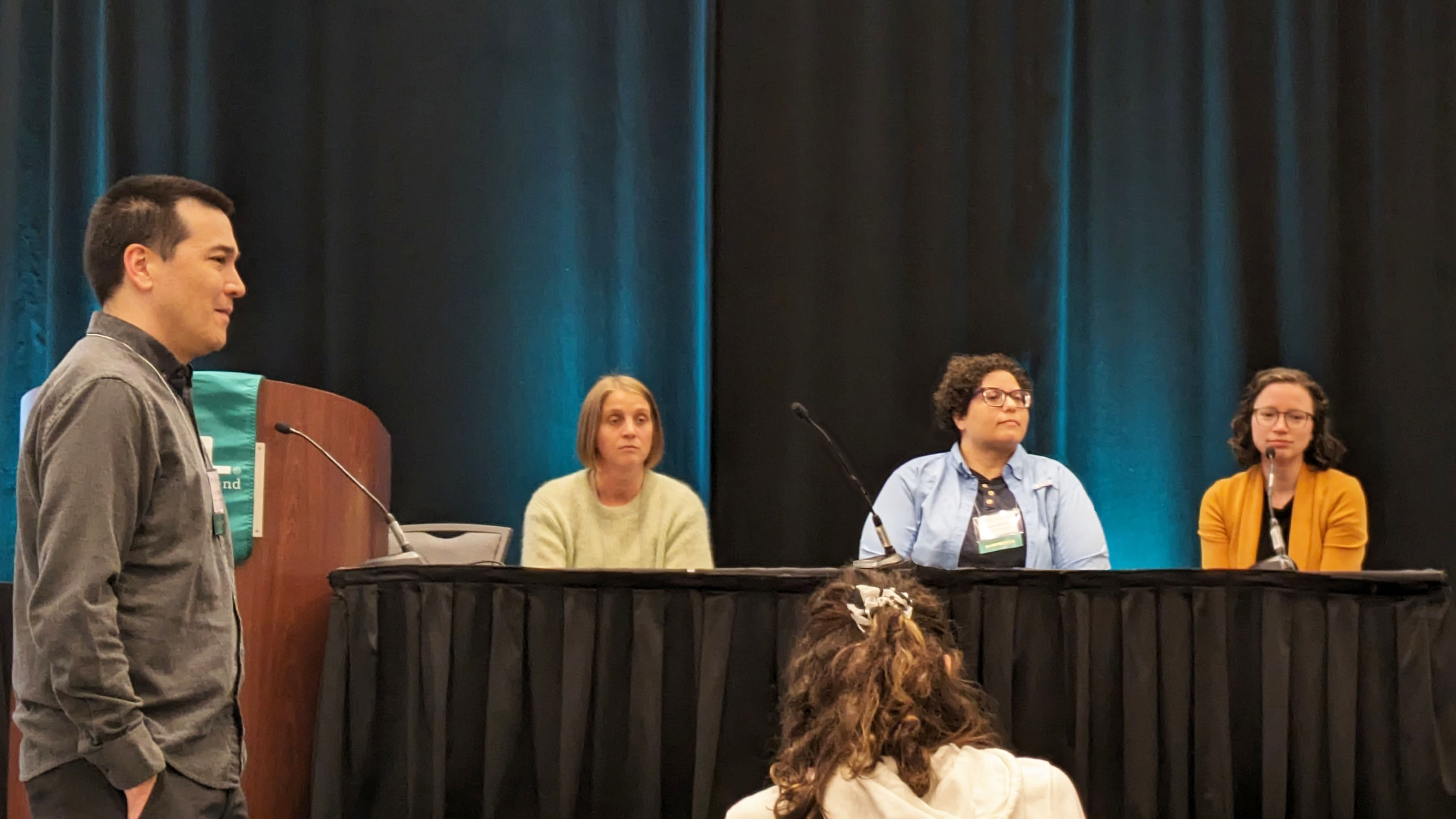
The discussion then turned to job-hunting strategies. The last several years have seen an increase in the availability of remote positions, providing additional avenues for researchers to find placements that align with their ambitions and values. Unfortunately, recent layoffs in the tech industry have simultaneously tightened the job market. As such, it is especially important that job seekers highlight specific projects in their application materials that directly relate to their desired career paths. Online platforms like Kaggle are great resources for activities that can later serve as concrete interview talking points.
Although Jackson sent out a relatively small number of applications before securing a postdoctoral appointment at Sandia, she was forthright about her desire to convert to a full staff position at the lab. “If you want to have competing offers and boost your salary, there is a little bit more strategy in being aggressive and seeking lots of job offers,” she said. On the other hand, Thorarinsdottir commented that the application portfolios of people who apply for too many positions may become generic and untargeted — and hiring managers will notice. She hence advised attendees to focus on positions that they genuinely find compelling.
The timeline for job application submissions compared to graduation date varies by field and company. If a soon-to-be graduate applies well before their feasible start date but submits a strong portfolio, some places may wait to hire them. “If you’re good and apply to something you really want and they really want you, they will wait for you,” Thorarinsdottir said. However, other organizations may operate on more rapid timelines and seek to fill open appointments as soon as possible. Either way, it never hurts to take a chance. “If you think a place might work for you, submit your things and just see where the chips land,” Jackson said.
Nadeau began the job search process by chatting with all of her contacts in industry and inquiring about their responsibilities. When one of her colleagues asked her what she wanted to do, Nadeau reframed her thinking and determined that she felt motivated by sustainability questions. She then began asking individuals in her network if they could connect her with people at their companies who worked in her targeted domain, which led to interview opportunities.
Reaching out to professional acquaintances in this capacity can be intimidating, but referrals to new contacts are almost always helpful. Even without a direct connection at a company of interest, crafting a tailored message and demonstrating legitimate enthusiasm increases the likelihood of a response. Additionally, potential employers find it easier to respond if an initial message inquires more broadly about general opportunities, rather than immediately requesting an interview. “If it’s a place that you’re really interested in, it also doesn’t hurt to follow up,” Nadeau said, adding that the recipient might have missed the original message.
While many people naturally transition to industry after graduate school, former academics should nonetheless make a concerted effort to market themselves for industry positions. Nadeau recommended that candidates craft a one-minute elevator pitch that serves as a condensed introduction to their personal story, skills, and goals. “Have some sort of motivation of why you’re interested in the types of jobs that you’re applying to,” she said. “People want to connect with you on a human level. They want to know that they can work with you and understand your motivation.”
To effectively communicate these incentives, candidates must first explicitly define their career goals and articulate them in a succinct manner. “You have to explain why you, as a person, want this job,” Thorarinsdottir said. “That holds for whatever job you’re applying for.” Doing so often requires pivoting between different levels of technical descriptions and breaking down ideas for non-experts in an approachable, non-condescending way.
The panelists next addressed potential tensions between the pursuit of novel mathematical methods versus the use of established techniques to answer real-world questions. In many settings—particularly when simultaneously managing the varying expectations of multiple different people—researchers must trust themselves to strike a balance between these two sides. Jackson especially feels this distinction when writing proposals, as funding is typically bucketed into either fundamental or applied science. Difficulties can arise when a project is potentially too fundamental for the applied fund or too applied for the fundamental fund; applicants must then decide which aspect of their work to emphasize. Regardless, Jackson first determines whether a call for funding involves a topic area that excites her. If it does, she crafts a proposal that responds to the specifics of the funding opportunity and addresses the corresponding need within the scientific community.
Thorarinsdottir typically tries to balance applications for funding opportunities that have high acceptance rates with the pursuit of projects that most interest her. “You have to be a bit flexible here because the best money you’re going to apply for is the money you’re going to get,” she said. Nadeau brought a different perspective, as she does not have to apply for funding in her industry role. However, other groups at C.H. Robinson occasionally ask her team about particular analyses or tools, which ignites a conversation about the requisite funding for completing a task internally versus hiring an external contractor or buying a product.
To conclude the panel session, Nadeau confirmed that numerous industry positions focus on both analytics and environmental concerns. “If sustainability is important to you, those jobs exist and should continue to grow,” she said. She also reassured listeners that many people successfully find work that is not directly related to their Ph.D. dissertation if their interests have shifted. Jackson encouraged current mathematics students who are passionate about environmental science to seize the flexibility of the academic setting and take classes beyond the realm of mathematics and statistics. “Having some experience in the language of the domain side will help you approach it on the math side,” she said.
Ultimately, building a career based on one’s interests and passions is always a personal journey. “If I had to give my former self advice, it is to not worry so much — everyone’s path is winding,” Thorarinsdottir said. “Do not worry so much about closing doors. There are many doors.”
About the Author
Jillian Kunze
Master's student, Drexel University
Jillian Kunze is the former associate editor of SIAM News. She is currently a master’s student in data science at Drexel University.
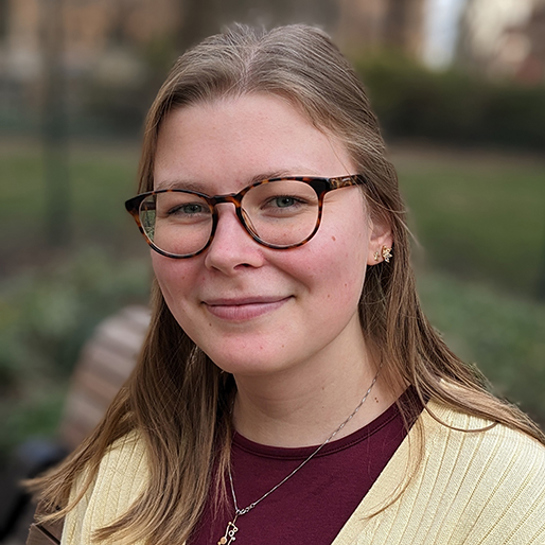
Stay Up-to-Date with Email Alerts
Sign up for our monthly newsletter and emails about other topics of your choosing.



